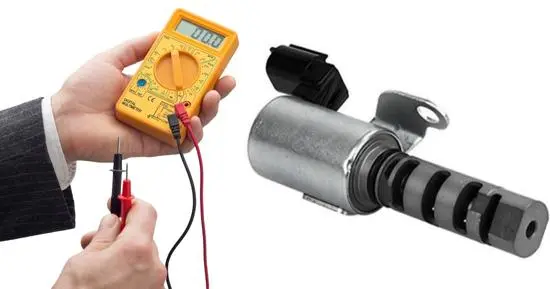This is a guide for the test of a VVT solenoid with a multimeter. The variable valve timing solenoid is present in almost all automotive cars where they control the activities of the engine of that car. However, they have different names given by the authorities.
For example, the vvt system of Ford is called the Ti-VCT system, and the vvt system of BMW is called the VANOS system.
These vvt solenoids are present and perform different functions, which in the end, are responsible for the engine’s working.
The vvt solenoid at the end makes an engine work worthy. But it is not only a single small part or a wire; it is a system in which different parts work together.
There are two types of vvt systems. The one is called the standard engine, and the second is the automatic system. The timing for the opening and closure of the valves in the standard engine is fixed. Still, the automated and modern VVT system can adjust the valves’ opening and closing timing.
That’s why the efficiency of the modern VVT system is more than the standard one.
Table of Contents
ToggleFunctions of the VVT solenoid
The VVT system, which consists of the VVT solenoid, has different functions in the engine. It covers the following parts.
- It helps to make the emission control system of the engine perfect.
- It can provide an easy and smooth idling.
- It helps to boost fuel economy.
- It makes the quality of the power delivery better.
That is why the VVT system is considered the essential part when it comes to the performance of the engine.
But different issues can cause faults in the vvt solenoid of the vvt system, which doesn’t provide the exact response to us.
Common faults occur in vvt system.
When the pressure on the engine increases, the VVT solenoid system starts to manage this pressure and provide enough support to the engine. Still, it can also affect the performance of the solenoid system.
There are different reasons which can cause a fault in the solenoid.
- The most common cause of the failure of the vvt solenoids is the dirty oil of the engine.
- When we do not change the oil of the engine, then it leads to destroying the performance of the solenoid.
- Because of the debris and dense oil layers on the engine, the vvt solenoid fails to perform its function.
- VVT systems get activated when there is a high RPM value.
- Where there is high pressure on the engine, then the vvt system works, but sometimes the extra oil gets added to the gears of the vvt solenoids, which can cause the vvt solenoid to malfunction.
- So if the car engine’s RPM is fluctuating, it can cause the failure of the vvt solenoid.
Common signs of the vvt solenoid failure
- VVT solenoid helps to open and close the intake valves when it is needed
- If the intake and exhaust valves’ closing and opening timing fluctuate, it is a sign of VVT solenoid failure.
- There is always an engine control unit (ECU) is present in the modern cars
- This unit helps to know the automobile’s owner if there is any fault in the inner system of the vehicle.
- If the ECU is giving you a sign code or blinking the light repeatedly, it is a sign that your VVT solenoid has become faulty.
After getting on the science and reasons of the vvt solenoids, now it is the time that you can practically check the vvt solenoid. This test uses the multimeter because it will help you know the reason and the type of fault that has occurred in the vvt solenoid.
How to test a VVT solenoid with a multimeter
Before testing the VVT solenoid, you should know about the equipment required for this test.
So here is the list of the tools that are necessary for you when you are going to check the VVT solenoid with the multimeter.
Tools required for the test:
- Safety gloves
- Diagnostic tool
- Safety goggles
- Digital Multimeter
Now we will move towards the quick testing procedure:
- In the first step, you must turn off all the electrical connections to the VVT solenoid.
- You must turn on the ignition key without starting the vehicle.
- After this, please turn on the multimeter and set it according to the test requirement.
- Turn the dial of the multimeter toward the DC voltage option.
- Now you can see the two leads there.
- You have to connect these two leads with the appropriate electrical connections.
- After connecting the leads, you have to see the digital screen of the multimeter.
- If you see any voltage readings on the multimeter, your solenoid functions correctly.
- But if you do not see any of the voltage readings on the display screen of the digital multimeter, then it means there is a fault in the engine’s wires.
- For this, you have to check the shorts in the wires.
Final verdict
A variable valve timing system is of great importance. When the car is driven uphill, pressure builds up on the engine. In this condition, the variable valve timing system, with the help of the vvt solenoid, comes to rescue the situation.
But if the vvt solenoid gets faulty, it will lead to improper engine functions.
As the car owner, it is your responsibility to keep everything up to the mark so that nothing can damage your automobile’s condition. Here in this article, we have told you how to check the vvt solenoid’s condition with the multimeter’s help.
You can follow this procedure for different vvt systems. So follow the above-explained steps and check out the condition of your VVT solenoid by using the digital multimeter.
Related Guides:




